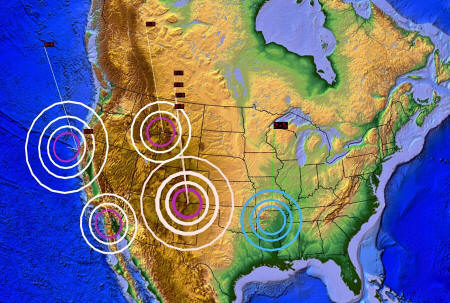|
|
|
The US Geological Survey (USGS) has released a map (Documentation for the 2014 Update of the United States National Seismic Hazard Maps) of potentially hazardous areas prone to earthquakes with percentages and probabilities for insurance corporations, city planners and other companies that would lose billions to a disaster.
Mark Peterson, seismologist for the USGS and lead author of the report said:
The hot spots indicated by the USGS map include:
Shockingly, the entire North American continent has the potential to suffer from an earthquake.
However 16 states have recently reported seismic activity near the 6 magnitude on the Richter scale.
The NMSZ has experienced more than 200 recorded earthquakes.
Seth Stein, seismologist for Northwestern University (NWU) commented that,
Based on the predictive model known as the Uniform California Earthquake Rupture Forcast (UCERF), predictions that are assumed "plausible" can be rendered and actions based on those predictive models can dictate future methods of reactions.
Peterson does not acknowledge that hydraulic fracturing (fracking) is causing seismic activity across the northern continent.
He said:
A recent study (Sharp Increase in Central Oklahoma Seismicity 2009-2014 Induced by Massive Wastewater Injection) was published by researchers from Cornell University (CU) showing that recent surges on earthquake activity are correlated directly with fracking.
The 40% higher incidents in earthquakes in Oklahoma since 2009 have been found to have origination with four injection wells that have been filled with chemical laden water used in the process of fracking.
It appears to geologists that injection wells concentrate so much chemical laced water into the earth’s crust that there is an obvious increase in subterranean pressure near these underground faults which is causing the recent rise in earthquakes.
Two years ago, the fact that fracking causes earthquakes are furthered by, a study (Earthquake Triggering and Large-Scale Geologic Storage of Carbon Dioxide) published by the Proceedings of the National Academy of Sciences, stated that the current method of carbon capture by storing the greenhouse gas underground used by fracking is directly causational to earthquakes.
In 2012, the Federal Emergency Management Agency (FEMA) released a statement alerting residents that on October 18th at 10:18 am (EST), on the Southeast coast of America, there would be an earthquake drill wherein 1 million residents over 5 states would be participating.
States such as Georgia, South Carolina, North Carolina, Virginia, Maryland, and the District of Columbia will collaborate with "schools, businesses, organizations, government agencies, communities, and households" as well as "many other local, state, federal and volunteer partners."
All across the US, participation will include:
Called the Great ShakeOut, this drill is directed toward residential homes, schools and organization to,
Earlier this year, geologists and scientists in Ohio discovered probable cause to believe that those sudden mild earthquakes (SME) experienced in the region of late and fracking are correlated.
The Ohio Department of Natural Resources (ODNR) stated:
Emily Brodsky, seismologist with the University of California at Santa Cruz (UCSC) explained:
Brodsky continued:
|



